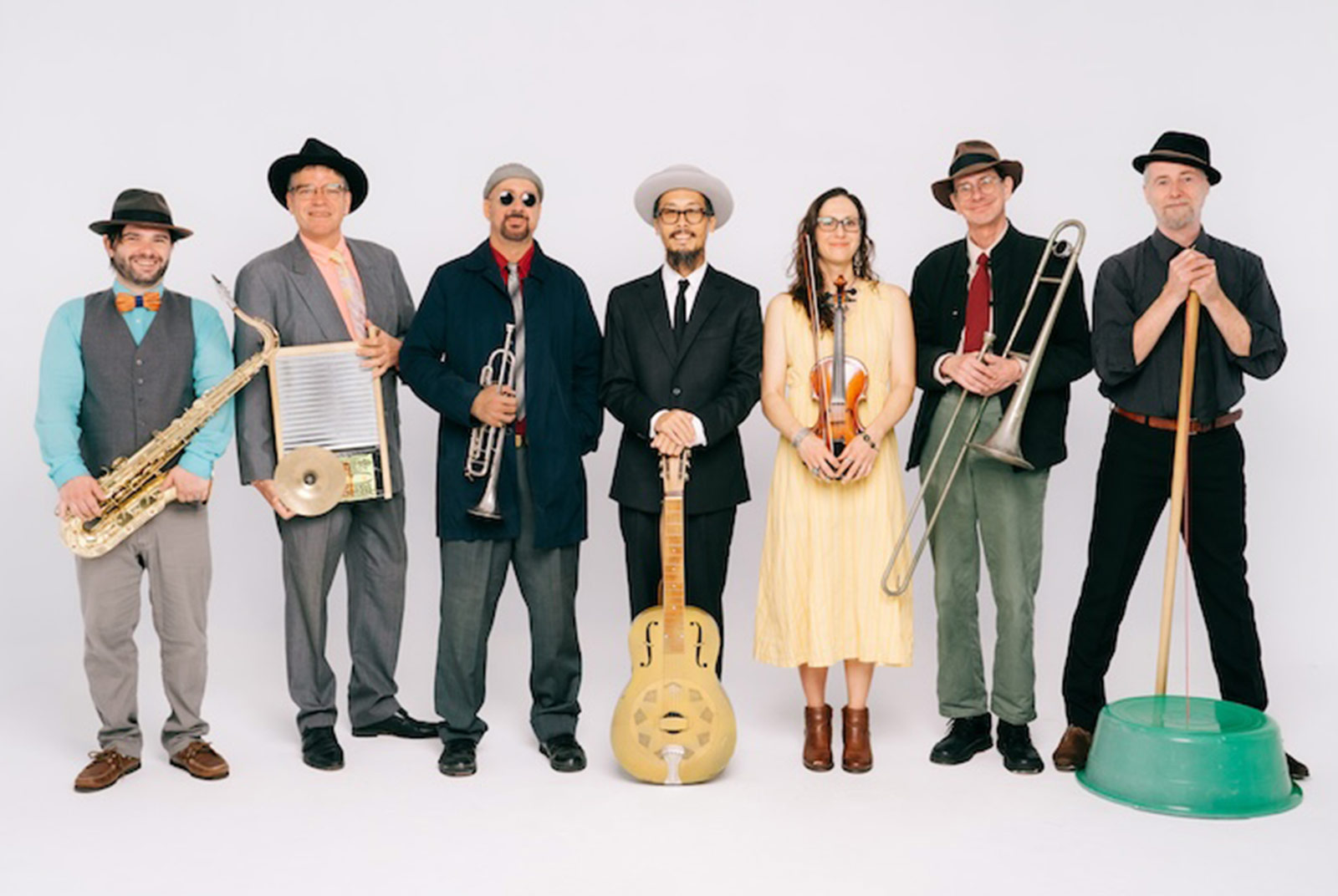Traveling in Taiwan
13 Tips for having a deeper Taiwan Temple experience

Source:flickr@Arthur Lai CC BY 2.0
Taiwan has thousands of temples, ranging from large multi-story buildings bearing multiple shrines and countless deities to small single-shrine structures barely big enough to fit a single god. Taiwanese temples can be dedicated to Taoist, Buddhist or Confucian beliefs, and often times multiple faiths (and deities) coexist peacefully under one roof.
Views
13 Tips for having a deeper Taiwan Temple experience
By Taiwan Sceneweb only
Presenting a cacophony of fragrance, color and sound, a Taiwan temple visit can sometimes be a bit overwhelming to the uninitiated.
Stephanie Huffman (a Masters Student in Asian Studies from NCCU who’s recently returned from both Xiao Liuqiu and Tainan on a series of extended Taiwan Temple Tours) shares a few handy pointers on things to look out for in order to better understand any temple in which you might find yourself.
Stephanie starts with a simple suggestion, namely…
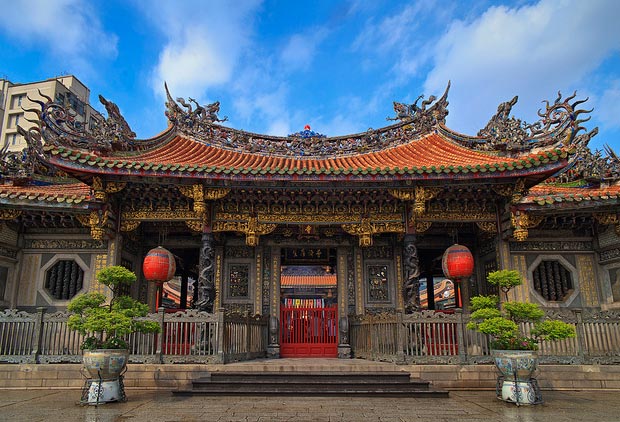 Flickr@tomasfano CC BY-SA 2.0
Flickr@tomasfano CC BY-SA 2.0
1. Pause before entering
Many temples have a raised wooden lip at the front of the temple, and this is meant to be stepped over (never on). On a deeper level, the raise lip is meant to give the visitor a moment to pause before entering. So before you go in, take a step back and look up to the roof. There will be dragons painted in a multitude of colors and possibly other animals depicted.
2. Check out the temple roof
You may see three figures standing in the center. These figures represent the three things Taiwanese worshippers generally pray for at a temple, namely fortune, luck and longevity. Another thing you may see on the temple roof is a carved pagoda. Like nearly everything about a Taoist temple, this too is fraught with significance. The more floors on the pagoda, the higher up the deity to which the temple is dedicated stands in the “bureaucracy of gods.”
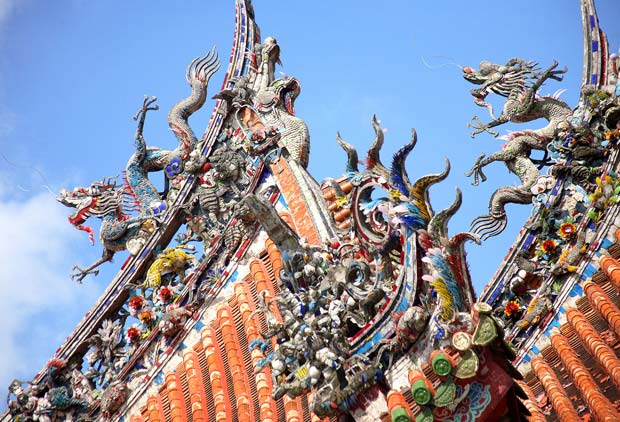 Flickr@kabacchi CC BY 2.0
Flickr@kabacchi CC BY 2.0
But even to this rule, there’s an exception: Confucian temples sometimes have pagodas with nine floors, the maximum number. This is to signify the high regard in which Confucius is held despite the fact that that the great scholar is not considered a deity.
3. Get to know the dragons
The dragon is a very important creature in Chinese culture and if you look closely you may notice how they are an amalgamation of different animals. The dragon’s eyes are said to be either cat or lobster eyes that enable it to see in the dark. Its head is said to resemble a camel although some sources say the nose is that of a dog. A dragon’s horns are from a deer, its mouth is from an ox and the whiskers are from either cat or catfish. The animal’s scales are from fish and its mane is said to resemble a lion’s mane. The dragon’s claws are eagle’s claws and sometimes its feet are said to resemble the paws of a tiger. Dragons can be depicted in alternative shapes and can take the shape of tortoises or horses with dragon heads. In Chinese culture, there’s no such thing as a standard dragon!
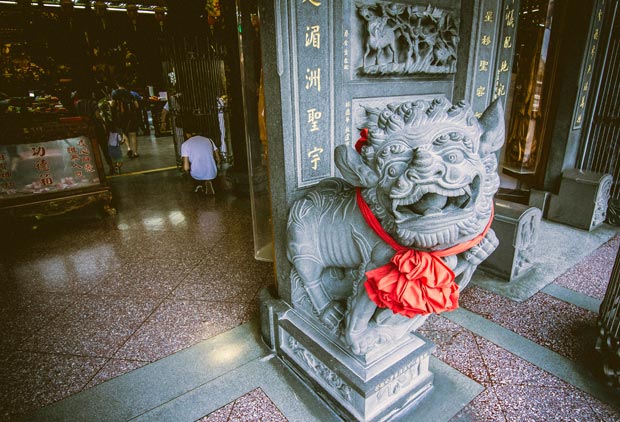 Flickr@jirka_matousek CC BY 2.0
Flickr@jirka_matousek CC BY 2.0
4. Gaze into the lion’s mouth
A common feature of many temples are its stone lions. Though sometimes identical, more often than not they’ll be different genders. Standing in front of the temple and looking inwards look to the lion on your right. This one is male and is regularly portrayed holding a gold coin. The lion on the other side is female and is holding a baby lion. If the lions mouths are open look for stone inside move. The lions will often have balls inside of their mouths. Sometimes these are mere spherical stones, but often these will be ornately carved, with smaller movable balls inside the larger ball. These balls are largely decorative, but the serve another purpose, namely to advertise the carving skills of the lion’s creator. Feel free to stick your hand in the lion’s mouth (if you dare).
OK, now you’re ready to enter the temple. But you may well be faced with three doors. Which should you use? Again, it comes back to our ancient friend the dragon.
5. Enter dragon, exit tiger
The right door (as you’re facing the temple) will often be adorned with artwork depicting a dragon, while the left will often have artwork depicting a tiger. This corresponds with the order one should enter and exit a temple. In Chinese culture, it’s considered auspicious to enter with the dragon (right) and exit through the tiger (left). What about the center door? That one is reserved for the gods themselves (and the occasional presidential visit).
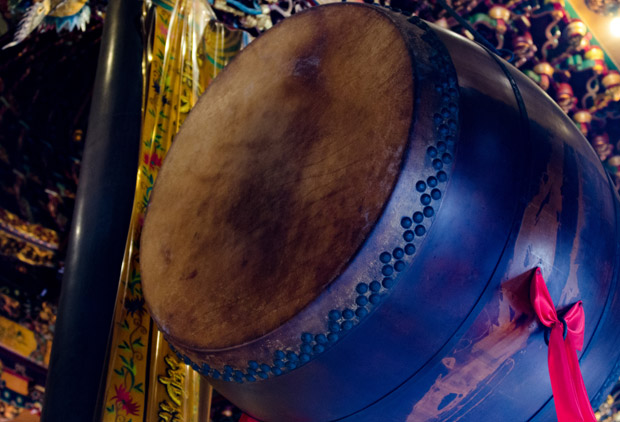 Flickr@xiquinho CC BY 2.0
Flickr@xiquinho CC BY 2.0
6. Orient yourself with the bell and the drum
After entering the temple look up; you’ll very likely see a large bell on one side, and a drum on the other. This is a good way to orient yourself, as the bell will always be in the east (to greet the dawn) and the drum will always be in the west (to announce the temple’s closing at dusk). Some bells and drums are considered antiques and are only there as ornaments. In any event, the bell and drum setup can be found in many temples throughout Taiwan. (Visit Baoan Temple, recipient of a 2003 UNESCO Asia-Pacific Heritage Award)
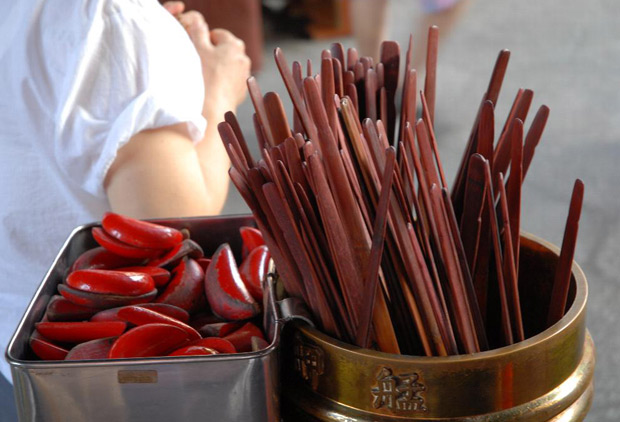 Flickr@gpaumier CC BY-SA 2.0
Flickr@gpaumier CC BY-SA 2.0
7. Mind your manners
In some temples, visitors are asked to exchange their street shoes for slippers, though in most city temples this isn’t the case. Check out what other visitors are doing and do the same. As tempting as it may be, refrain from pointing. It is considered taboo to point at gods. Instead, gesture with an open hand as if gesturing to another human. This is an accepted and polite way to point out items of interest. Photography is generally allowed as long as you are mindful of worshippers. Try to avoid standing between a worshipper and the incense brazier. (The Old Taipei – Introducing the city’s Dadaocheng Area)
8. Question the gods
Taiwanese temples have a way to communicate with the gods. Jiaǒ Bei (筊杯)are red crescent shaped pieces of wood. One side is flat, the other curved. Here’s how to use them: Hold the blocks in your hand before the altar and silently ask the gods a simple (“yes” or “no”) question before dropping the two blocks on the ground. Both curved sides facing up indicate a negative answer (Yin Jiaǒ, 陰筊). If both curved sides face the bottom, causing the blocks to rock side to side, this is also a negative answer(Siaò Jiaǒ, 笑筊). (Some interpret this result as laughter from the gods , meaning that they consider the question irrelevant.) When one flat side is facing up and the other flat side is facing down this means the gods are giving a positive answer to the question asked(Shèng Jiaǒ, 聖筊). If one or both blocks lands on one of their edges this means the gods did not understand the question and it should be reworded.
Jiaobei can be tossed between one and three times for any particular question.
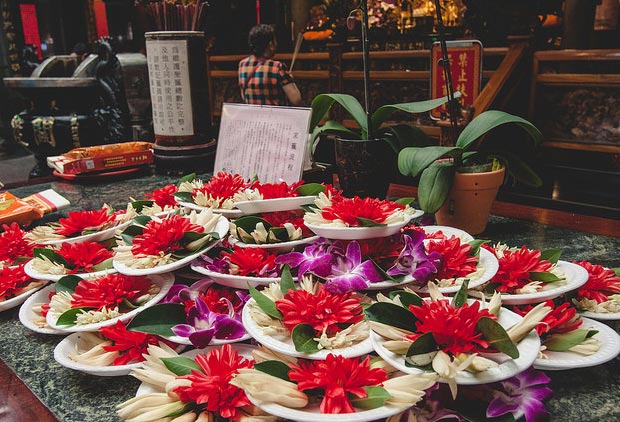 Flickr@jirka_matousek CC BY 2.0
Flickr@jirka_matousek CC BY 2.0
9. Take note of the offerings on and around the altars
There may be plates of food or flowers on the tables before the deities. These are offerings to the gods. Food offerings to gods are traditionally raw and uncut so fresh fruit is common. Packaged food is a more contemporary offering. If you see tea cups on the altar before a god look closely, as these will sometimes be filled with fresh tea. Various deities will have offerings specific to them; for example, a goddess figure may have beauty products or flowers, while a god of agriculture might be offered rice and produce.
10. Look beneath the main altar
Facing the main altar be sure to look underneath the offering table near the floor. There may be a small alcove with a small figure or offerings. If there is a tiger in the alcove this is Hǔ Yéh. Hǔ Yéh (虎爺), or Lord Tiger, can be found at many Taoist temples and is considered a guardian spirit. Reverence of tigers can be traced back to nature worship in China.
11. Check out the smaller altars as well
If visiting a larger temple look for a passageway past the main god’s altar. This will lead to more additional altars in the back featuring other deities. These deities can range from Tǔ Dì Gong (土地公), a local earth god that people pray to for money, to the Matchmaking God, Yue lao, that people pray to for help in meeting a romantic partner. Incense burners and Jiaǒ Bei can also be found in front of their shrines. (Discover Longshan Temple, one of Taiwan’s most visited religious sites)
 Guang Ming Deng. (Flickr@macabrephotographer CC BY-SA 2.0)
Guang Ming Deng. (Flickr@macabrephotographer CC BY-SA 2.0)
12. Pause to take note of the wall of lights
While visiting you may see a wall of lights containing dozens, perhaps hundreds in larger temples, of small boxes with small statues inside. These are called Guang Míng Deng(光明燈), or blessing lights, and have been reserved for worshippers’ loved ones. A donation to the temple reserves ones of these statues, which typically takes the form of the main temple deity. If you look closely you will see the recipient’s name underneath the small statue. The number of guang ming deng are a good indicator of the overall importance of the temple you’re in to the local community.
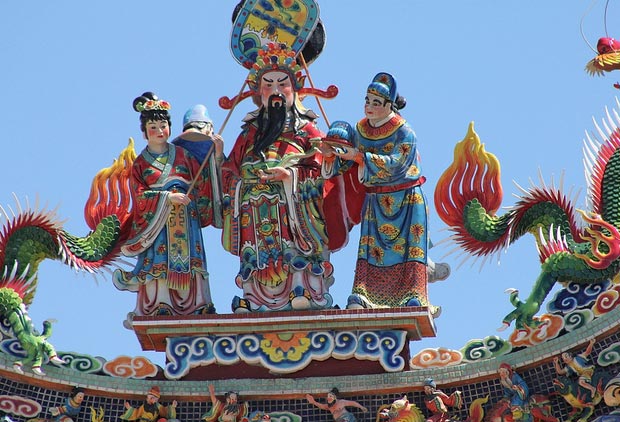 Flickr@patcullen CC BY 2.0
Flickr@patcullen CC BY 2.0
13. Appreciate the artwork
Art is a major feature of Taiwan’s temples, with nearly all temples big and small featuring artwork, from stone relief carvings depicting well known stories from Chinese history and mythology to hand carved tablets bearing Chinese idioms both well known and obscure. Though there are similarities among temples in Taiwan there are unique aspects to each one. Visiting multiple religious sites will show you the multitude of ways religion flourishes in Taiwan. (Engage with local experts in traditional Chinese art and culture)
About Taiwan Scene
Taiwan Scene is the online journal of Taiwan Scene.
We publish stories introducing readers to the culture, scenery and travel possibilities of our homeland, articles to help travelers make the most of their time in Taiwan, and occasional interviews with movers and shakers from Taiwan’s ever-expanding creative scene.
Prolonged exposure to Taiwan Scene may instill in readers a profound desire to experience Taiwan personally. If these cravings persist, please contact us immediately.

Original content can be found at the website of Taiwan Scene.
♦ 13 Tips for having a deeper Taiwan Temple experience
This article is reproduced under the permission of Taiwan Scene and terms of Creative Commons Attribution-NonCommercial-NoDerivs 4.0 Unported License (“CCPL”). It presents the opinion or perspective of the original author / organization, which does not represent the standpoint of CommonWealth magazine.





